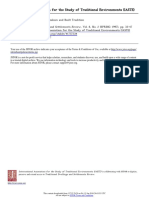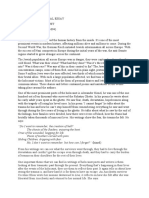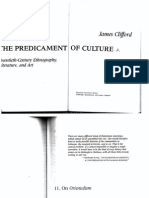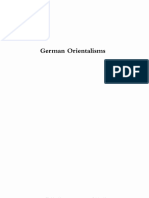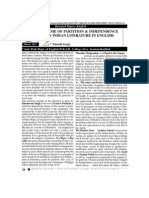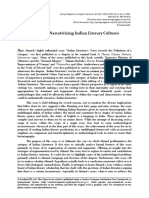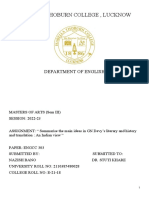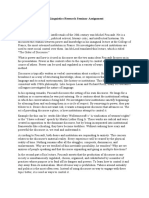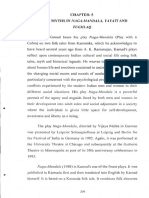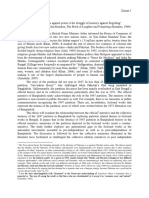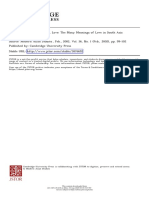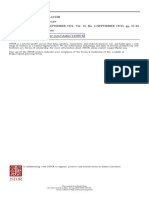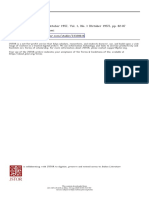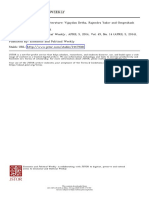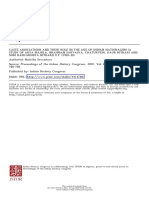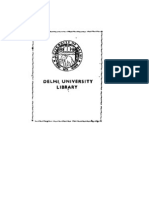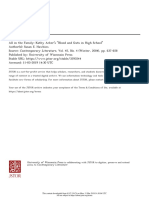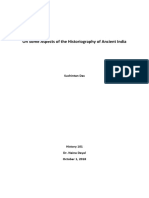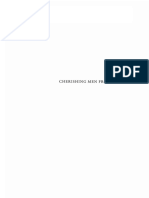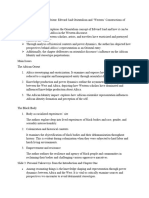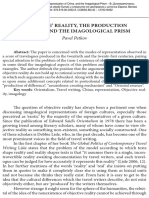Genealogies of Indian Literature
Genealogies of Indian Literature
Uploaded by
ParulCopyright:
Available Formats
Genealogies of Indian Literature
Genealogies of Indian Literature
Uploaded by
ParulCopyright
Available Formats
Share this document
Did you find this document useful?
Is this content inappropriate?
Copyright:
Available Formats
Genealogies of Indian Literature
Genealogies of Indian Literature
Uploaded by
ParulCopyright:
Available Formats
Genealogies of Indian Literature
Author(s): P. P. Raveendran
Source: Economic and Political Weekly , Jun. 24-29, 2006, Vol. 41, No. 25 (Jun. 24-29,
2006), pp. 2558-2563
Published by: Economic and Political Weekly
Stable URL: http://www.jstor.com/stable/4418380
JSTOR is a not-for-profit service that helps scholars, researchers, and students discover, use, and build upon a wide
range of content in a trusted digital archive. We use information technology and tools to increase productivity and
facilitate new forms of scholarship. For more information about JSTOR, please contact support@jstor.org.
Your use of the JSTOR archive indicates your acceptance of the Terms & Conditions of Use, available at
https://about.jstor.org/terms
Economic and Political Weekly is collaborating with JSTOR to digitize, preserve and extend
access to Economic and Political Weekly
This content downloaded from
223.185.129.210 on Mon, 10 Aug 2020 03:09:27 UTC
All use subject to https://about.jstor.org/terms
Genealogies of Indian Literature
Since who or what is "Indian" has always remained a matter of contention, the
term "Indian literature" becomes even more difficult to define and understand. Literature
in India is as old as its paintings or its sculpture, but a sustained pursuit of its history began
only at the dawn of the 19th century. That is when Indian literature became a
theoretical category. But from the Sanskrit bias of early European Indologists,
to the reformist-nationalist-modernist projects, to the ease with writing in English,
literature in India has traversed diverse terrains.
P P RAVEENDRAN
n recent days there has been a great deal of debate on the
found immediate acceptability in the Oriental world in the era of
significance of the two words "Indian" and "literature,"modernity and colonisation. What all this suggests is that the
though not always in a contiguous context, and certainly not cultural roots of Indian literature and Indian sensibility
on the same level of theoretical and political resonance. Taken should be construed as running deeper and stronger than the roots
separately, neither "Indian" nor "literature" would elicit uniform of the corresponding tendencies in the socio-economic realm.
response even from the common reader. While who or what isWe are grappling here with questions of knowledge formation,
"Indian" has always remained a matter of contention among and in this context it is worthwhile to remember that knowledge
sections of the citizenry, especially in post-independence India, is not a neutral category that gets circulated in a society in an
what constitutes "real" literature has also been a matter of serious unmediated way. In fact certain segments of the society decide
debate, more particularly in these turbulent times when thewhat is to be counted as knowledge in given moments of social
conflicting claims of a fragmented public on the society's cultural development. If knowledge in India with its long history of
capital have proved to be a little too difficult to settle. Theimperial rule continues to be tainted by colonial ideology even
wrangles on the political and social fronts that the country after 57 years of independence, it only proves Gramsci's thesis
witnessed after the events in post-Babri Ayodhya and post- that material presence is not essential for the exercise of cultural
Godhra Gujarat, are pointers to the semantic difficulties asso-leadership by a dominant group over an underprivileged group.
ciated with the word "Indian". Similarly, at the centre of the newlyImperialism must have come to an end, but not the "Empire",
proliferating body of dalit and female writing appearing in almostas Michael Hardt and Antonio Negri recently proclaimed.1 This,
all the Indian languages today is an uncertainty regarding its statusnotwithstanding the theoretical distinction they want maintained
as "literature" or perhaps as "Literature". between the two concepts, as the lineaments of the decentred
To link the two terms and talk about a unified "Indian literature" and deterritorialised cultural empire evolving in India today does
in such a contested terrain would seem a little perverse. Morenot seem to be far removed from the global scenario appearing
perverse is the attempt to elaborate a concept of Indian literaturein their cartography. Literary scholars in India then will have
connected by a commonly shared sensibility. In the fast-changing to be self-critical about colonialism's impact on their own cultural
global scenario of economic liberalisation and cultural responses that leads to the building up of a new empire. This
recolonisation, where artistic sensibilities are expected to lose will also make it imperative for them at this juncture in time,
that is, after more than five decades of independence and 500
their regional flavours and merge into an international sensibility
of global currency, such an attempt might lead to further prob- years of colonial and imperial rule, to rethink concepts like
lems. Alternatively, just as the advocates of liberalisation and Indianness, Indian sensibility and Indian literature a little more
globalisation nurse fond hopes of a strengthened Indian polity closely and critically than has been done before, so that they might
and economy to emerge from the present global climate, the uncover the complicity of these concepts with the
proponents of cultural globalisation too visualise a reinforced ideology of colonialism on one hand and that of globalisation on
the other.
Indian sensibility and Indian literature to come out of the present
imbroglio. But if we examine things a little more closely, we
realise that unlike in the spheres of economy and polity, the Indian Literature: A Contested Category
warring supporters of global and Indian senrsibilities are not likely
to remain at loggerheads with each other in the literary sphere. A literary sensibility, needless to say, always operates in the
This is primarily because there has been in vogue, at least since
context of a unified body of literature and an integrated literary
India came into contact with the European literary ideology, a
culture. Can we in the present context speak about such a unified
strong perception that the literary experience is perhaps universal
body of Indian literature and an integrated environment of Indian
in significance. Goethe's Weltliteraturand Tagore's Viswasahitya,
literary culture? Before attempting to answer that question it
might be pertinent to point out that "Indian literature", an
both meaning "world literature", were attempts at theorising this
perception, though the Euro-centric bias of the two concepts ontologically unified object that is theorised as connected by a
escaped the notice of the two visionaries in their own times. The
shared discursive history and shared epistemological concerns,
is not the same as "literature in India" or "literatures in India".
perception certainly was at the heart of ancient Sanskrit poetics
as well, which obviously was one reason why the European view Very few accounts of Indian literary history are seen to maintain this
2558Economic and Political Weekly June 24, 2006
This content downloaded from
223.185.129.210 on Mon, 10 Aug 2020 03:09:27 UTC
All use subject to https://about.jstor.org/terms
vital distinction. The title of the influential Chicago University what one is to understand from this is that in spite of the enormous
primer, The Literatures of India, seems to recognise this point, scholarship that has been produced on Indian literature by schol-
although the individual essays clearly do not share this ars of various hues from the south Asian subcontinent, the
recognition.2 Literature in India, as any textbook history of Indian European scholarly attitude to this archive remains unchanged
culture would tell us, is as old as its painting or its sculpture, from what it was in the 19th century represented by the works
perhaps a little less old than its community life. Sustained schol- mentioned. All these works without exception also shared the
arly pursuit of the history of this literature, however, is of fairly class and caste bias of the tradition of Sanskrit-based Hindu
recent origin and would not go back beyond the dawn of the orthodoxy. Some present-day critics recognise this, as i
19th century. This indeed is the moment of the constitution of indicated by the following comment of Sheldon Pollock in hi
Indian literature as a theoretical category. introduction to a recent anthology of essays on literary culture
This certainly is not to deny the self-knowledge of the identity from south Asia. Making references to the early work in
of the several regional literatures in India by regional language Indology by western scholars starting from Hegel and Schlegel
scholars in the past, though historiographic accounts of these Pollock says:
literatures too do not go far back beyond the early 19th century.
Sanskrit was posited as the classical code of early India, congruen
In fact the first histories of most regional languages too get written with new linked conceptions of classicism and class. .. .The rea
only during this time. It is around this time, again, that Indian plurality of literature in south Asia and their dynamic and long
literature gets constituted as a self-validating body of knowledge. term interaction were scarcely recognised, except perhaps inci
It has been pointed out that the first scholar to use this term was dentally by Protestant missionaries and British civil servants wh
not an Indian, nor were Indian scholars particularly interested were prompted by practical objectives of conversion and control.7
in tapping the unifying potential of the term in the 19th century.
It was the German romantic theorist Wilhelm von Schlegal, who The Theoretical Category
in 1823 used it synonymously with Sanskrit literature.3 Since then
a number of western Indologists have used the term to refer to The works by western Indologists mentioned above would
the unified literature of India, mainly Sanskrit, but at times also, bring the story of the constitution of Indian literature down t
along with Sanskrit literature, literatures written in Pali and the the first quarter of the 20th century. It is now that we see Indian
several dialects of Prakrit. Very rarely did modern north Indian scholars show interest in the emerging genre and pick up th
languages like Bengali, Urdu or Hindi find a place in the accounts blueprint of what was virtually a project conceived in the west
of these writers, though literary histories pertaining to some of Indian scholars who have theorised Indian literature in diverse
these linguistic cultures were appearing in parts of India during ways in the 20th century include K R Srinivasa Iyengar, Sri
this period. The strong tradition of Tamil literary culture that Aurobindo, Krishna Kripalani, Umashankar Joshi, V K Gokak,
had deep roots in entire south India or the Kannada tradition of Suniti Kumar Chatterjee, Sujit Mukherjee, Sisir Kumar Das, G
a somewhat later period also went unrepresented in their works. N Devy and Aijaz Ahmad. Most of these scholars with the obvious
M Garcin de Tassy's two-volume History of the Literature of exception of Aijaz Ahmad, whose sensitive and highly nuanced
Hindu and Hindustani (French original, 1839-47; revised, en- elaboration of the category of "Indian literature" is in effect an
larged and published in three volumes in 1870-71), Albrecht acknowledgement of the impossibility of positing such a cat-
Weber's History of Indian Literature (German original, 1852), egory, arrive at the broad possibility of conceiving an Indian
George A Grierson' s Modern Vernacular Literature of Hindustan literature either as the expression of an essential Indian culture
(1889), Ernst P Horowitz's A Short History of Indian Literature or as the unity of discrete literary formations.8 The reformist-
(1907), Maurice Winternitz's three-volume History of Indian nationalist-modernity projects that were under way in all parts
Literature (German original, 1908-22) and Herbert H Gowen's of India in the early 20th century acted as a great unifying force
History of Indian Literature (1931) are some of the literary at this juncture. So did the progressive literary movement (Indian
histories that contributed towards the constitution of the category Progressive Writers Association, IPWA), which launched in
of Indian literature.4 1939 ajournal under the titleNewIndian Literature from Lucknow.
T R S Sharma in the preface to his three volume anthology Since its inception in 1954, the Sahitya Akademi, under the
of Ancient Indian Literature, is indirectly referring to the Sanskrit tutelage of India's first prime minister Jawaharlal Nehru, who
bias of early European scholars when he dwells upon the practical was also the first president of the Akademi, has been propagating
problems that he encountered in locating translations of literature the idea of the unity of Indian literature by using the slogan
from ancient India. He says: "While many European scholars "Indian literature is one though written in many languages". The
had translated entire works of Sanskrit, few of them had ventured title of the Akademi's journal Indian Literature, echoing the
into Prakrit and Apabhramsa and none into Kannada."5 Even name of its short-lived IPWA forerunner, is more than symbolic
today European scholars of modern south Asian languages and in this sense.
literature feel compelled to legitimise themselves and their fields That Indian literature as a theoretical category was constituted
of study, working as they do in departments of south Asian studies in the 19th century would nowadays be disputed only by bigoted
- at times designated even now as departments of Indology - adherents of cultural revivalism. Many thinkers of liberal per-
that are dominated largely by classical Sanskrit scholars. This suasion can be seen, sometimes explicitly, but more often im-
is what one should infer from the introduction to a volume of plicitly, to be opposing this bigotry. Sisir Kumar Das's move
in publishing the last two volumes, the ones pertaining to the
modern south Asian literature and film written by scholars working
in European universities in which the editors unambiguously state
period since 1800, of his projected multi-volume history of Indian
that one of the motives behind the compilation of the volume literature can be read as an implicitcriticism of this bigotry.9 Though
is the need to let the world know of the "seriousness" of their the reasons given for publishing the eighth and ninth volumes
discipline.6 The unabashed eurocentrism of this statement apart,ahead of the volumes pertaining to the earlier periods is the easy
Economic and Political Weekly June 24, 2006 2559
This content downloaded from
223.185.129.210 on Mon, 10 Aug 2020 03:09:27 UTC
All use subject to https://about.jstor.org/terms
availability of material pertaining to the modem period, one analysis assumed that real and valuable contributions to Indian
cannot ignore the fact that in doing this he is also focusing on literature were made in ancient India, that is, in the past of India
the period when Indian literature actually came into being as an prior to the Islamic conquest. Very little of the present of literary
object of knowledge. Perhaps he is also suggesting that this India is explored in the literary histories mentioned above. Weber's
object's chronological extension back into the past is yet to be History ofIndian Literature discusses only the Vedic and Sanskrit
properly realised. This indeed is how all subject disciplines are periods of the Indo-Aryan language, while Winternitz surveys
conceived and constructed. An object of knowledge is constituted Vedic and Upanishadic literature as well as the writings in
as a discipline with well-charted boundaries and well-defined classical Sanskrit and Prakrit in his History. In doing this the
objectives in answer to certain political compulsions. Indian two were only following in the footsteps of Sir William Jones,
literature too, when constructed as a discipline, was meant to Indologist and the founder of the Asiatic Society of Calcutta,
answer certain political and ideological needs. who as early as 1786 had declared that in his studies he would
What are the ideological compulsions that rendered the con- be confining his researches "downward to the Mohammedan
stitution of Indian literature imperative in the 19th century? A conquests at the beginning of the 11th century, but extend them
closer look at the nature of the scholarship produced on Indian upwards, as high as possible, to the earliest authentic records
literature during the period in question would help us to under- of the human species."l0 Though some later scholars like George
stand this problem. The 19th century and after in Indian history, A Grierson have deigned to consider specimen texts from the
it may be remembered, is the period of colonialist and capitalist regional languages too, a good majority of early Indologists were
expansion, of social reform movements, of nationalist awakening resolutely opposed to the idea of treating works that belonged
and the freedom struggle leading finally to the country's inde- to Indian regional literatures of the modern period as part of the
pendence. It is also the period of increasing modernisation of Orientalist canon.
the society with its attendant good and evil effects, of an ex- It is against this background that Said's general observations
panding English studies programme, of a proliferating print on the politics of the Orientalist scholarship assumes significance.
culture, of the democratisation of the reading public and, in the There are problems with Orientalism both in terms of theory and
sphere of literature, of an overall consolidation of the western methodology, that led to the assumption, widespread among post-
ideology of the aesthetic. The impact of these diverse develop- colonial thinkers today, of the presence of an ahistorically
ments can be seen imprinted in the kind of scholarship on Indian homogeneous other in parts of what is called the third world,
literature that got constituted during this period. though one might find it difficult to concur on the basis of this
The developments indicated above are too panoramic and with Aijaz Ahmad's assessment of it as "a deeply flawed
complex for us to do justice to all of them in an analysis of this book".11 An important reality that the book has allowed us to
kind. But we'll briefly examine three issues that are intricately see is the deep ideological complicity between Orientalism and
related to the question of Indian literature and see how they have the project of colonialism. This indeed is a complex question
interacted with one another to produce the kind of scholarship on which much has been written by researchers, historians and
associated with the category of Indian literature. We have already social scientists of all persuasions, so that it might be well-nigh
made a passing reference to the first of these in our preliminary impossible to summarise the arguments or keep track of the
remarks on the tradition of Sanskrit-based Hindu orthodoxy that direction in which the research is progressing.12 In fact, it is
animated much of the work connected with Indology. We shall possible that the conflicting interests of the European powers on
also examine the question of language that has played a crucial the Indian subcontinent during the 18th and 19th centuries might
role in the construction of the category. The co-option of the be said to have cast their shadow on the Orientalist discourse,
category by the nationalist discourse for the production of the though Said has nothing to say on this. Whatever little has been
metaphysics of a national literary sensibility will be the third issue done by recent researchers on this question is enough to indicate
under analysis. that this discourse was saturated from the very beginning with
the claims and counter-claims of rival colonial powers, especially
Orientalism and After the English and the French in the Indian context.13 It is the
presence of such competing interests that goes to make this body
Much of course has been written on western Indology of
andknowledge
the ideological and its complicity with colonialism
real. The Orientalist's refusal to recognise the value and authen-
scholarship on Indian culture that it has generated. This especially
after Edward Said's path-breaking critique of Orientalism ticitywas
of the several kinds of modem literature in Indian languages,
published in 1978. One certainly cannot underestimate theis to be read as a manifestation of this complicity. One of
then,
enormous amount of research carried out on India by European the general studies on Indian literature by the Indologist Edwin
Orientalists of the 18th and 19th centuries. Much of what would Arnold, entitled Literature of India, was issued in 1902 from a
otherwise have been lost of classical Indian scholarship was press in New York called the Colonial Press. The suggestion
salvaged by the painstaking research of scholars like Charles might sound a little too cynical, but it would not be altogether
Wilkins, Albrecht Weber, William Jones, Henry Colebrooke, absurd to say that 'Colonial Press' would have made a suitable
Nathaniel Halhed, Max Mueller and Maurice Winternitz. How- imprint for a great deal of the Indological material published
ever, as several later scholars have pointed out, there is an during the period even outside the New York press.
important lacuna in their work plan and their output, which is The above complicity can be seen at work, though at a less
too systematic and too consistent to be treated as an instance conspicuous
of level, in the scholars' handling of the language
question. This becomes important because this was the key issue
casual oversight. This relates to the tacit concurrence that they
debated by the literati, especially the Anglicists and the Orientalists
gave to the division of Indian history into a predominantly Hindu
ancient India, a Muslim-dominated medieval India and a British in both India and Britain, for over three decades in the early years
of the 19th century till it was finally resolved by Macaulay's
designed modern India. Further, the general framework of their
2560 Economic and Political Weekly June 24, 2006
This content downloaded from
223.185.129.210 on Mon, 10 Aug 2020 03:09:27 UTC
All use subject to https://about.jstor.org/terms
"Minute on Education" (1835). The establishment in 1917 of of the first Indian novel in English, and Michael Madhusudan
Hindu College in Calcutta - an institution meant to propagate Dutt, one of the early Indians to make a name for himself as
secular values through "modern" (English) education, but which an accomplished poet in English, both renounced, like Ngugi wa
nevertheless flaunted a non-secular banner in its name - is a Thiong'O of Kenya was to do a century later, their youthful
enthusiasm
significant moment in this debate that has been characterised by for the English language and turned, at a more mature
contradictions and paradoxes. Outwardly the Orientalistsstage of their respective careers, to their own native language,
were
Bengali, and distinguished themselves as creative writers in that
against the introduction of English in India in place of Sanskrit
and Persian. Perhaps they earnestly believed, contrary to language.
the
position taken by many social reformers in India, that this was
a gravely mischievous step to take for the British administration The Language Question
in India. But the deep-seated identity of ideological interests
between the Orientalists and the British government on one History
hand repeats, and not always as farce. This is what we are
and the Orientalists and the Anglicists on the other can be to seen
gather from the recurrence of the debate on the feasibility of
using the English language by Indians for creative purposes in
in the refusal of all to honour the present of India represented
by its regional languages. Looking at things in retrospect we
post-independence India. But what scholars like Budhadev Bose
and and
realise that the real dispute was not between the Orientalists P Lal could not prove through their theoretical perambu-
the Anglicists, but between regional or local cultures and thelations
bigin the 1950s and 1960s, the novelists of Rushdie's gen-
eration
event represented by the great tradition of Indian culture that botha few years later have shown through practice: that the
the Orientalists and the Anglicists in their own separatelanguage
ways question, framed as a question pertaining to the per-
propped up. Macaulay did not want to do business with thespontaneity of creative expression, after all, was a non-
ceived
regional languages. As his Minute makes clear, the coloniser's
question as far as the politics of writing was concerned. One could
objective in spreading English education was to form a class excel of
and prove to be a creative genius in an alien language,
persons who could be depended upon in interpreting the land in the process all questions pertaining to the politics of
evading
and culture of India for the Britisher - a class immortalised in writing. This observation gains immense value when we remem-
Macaulay's oft-cited phrase, "Indian in blood and colour, but
ber that such politics was precisely what Bankimchandra and
M M Dutt were indirectly concerned with when they thought it
English in taste and opinion". The Orientalists and the Anglicists
fit to reject the English language as the medium of creative
both concurred with this view enshrined in the Minute. One might
expression in the 19th century. And certainly, one should also
perceive a subtle transition of intellectual authority taking place
here. a symbolic exchange, so to say, between the past glories remember that the writers of Rushdie's generation are working
in an altered cultural environment in which literature itself has
of Sanskrit and the present powers of English. The Orientalists
- and through their work the elite public opinion in India been- enlisted in the service of an unscrupulous global and
appeared to be conceding the modernised, Anglicised presentglobalised
of economic order by contemporary capitalism. Since
India to the colonial rulers in return for an acknowledgement
this is not the place to go into the details of that development,
of the glories of the country's Vedic and Sanskritic past, in
let aus leave that aspect unelaborated for the present.
process that Nigel Leask has aptly described, in a related context,
This problem concerning the language of literature will appear
"reverse acculturation."14 The process involved a legitimisationto be more relevant in a discussion of Indian literature, as literature
is always written in a specific language. OV Vijayan who brought
of the colonial rule whose burden it was to recover the past glories
and traditions of India that had fallen into decay arguably under
about a radical change in the literary sensibility of the Malayalam
the Muslim rule. This perhaps is how Said should make sense readers in the 1960s with his groundbreaking novel Khasakinte
to us. For if we followed this logic, what Said said was that Itihasam
the (1969), was in the habit of saying that one knows a
imperialists used the Orientalist's intellectual mastery over region by its characteristic fauna. The variety of fish that one
gets in Chennai will be different from what one gets in Mumbai,
India's past to legitimise and reinforce their own physical control
of the present. Tunis or Manchester. A place name can act as a metaphor for
a whole lot of characteristics - and this would include the smell
"Indian in blood and colour, but English in taste and opinion."
Macaulay's telling phrase invites to be deconstructed in of thethe fish one eats - that make up the identity of the people
context of the debates on language carried out with reference who inhabit the place. Language, a system of metaphors, at a
to Indian literature. Was Indian literature, at the time of its certain level can also be treated as a metaphor for the system
constitution, fashioned out to cater to the taste of the English?built up around a place. One is known by the language one speaks.
One should assume it was indeed so, as the works that were This is one reason why theorists say that language is ideological.
circulated in the name of Indian literature in the 19th centuryWhat this implies for the theorists of Indian literature, however,
were all classics in Sanskrit that were translated and - inasmuch is that an exclusive focus on the language of literature would
as translation constitutes misreading and misrepresentationrender - unsustainable formulations like "a literature written in
misread and misrepresented. Here then is a cartography of several languages." One might talk about Hindi literature, Tamil
misreading whose founding principles have been the subjects literature
of or Bengali literature, because these are kinds of lit-
debate from very early days. The debate was carried out with erature based on specific languages and linguistic cultures.
a great deal of vehemence in the first half of the 19th century, But can one talk about Indian literature, unless by that one
especially in relation to the rationale of developing an Indianmeans, as many 19th century Orientalists did, Sanskrit
literature written specifically in English. The history of Indian
literature, or as several present-day western critics mean, Indian
English literature would reveal that all early Indian English English literature?15
writers suffered from a profound sense of divided linguistic This question emanates centrally from the politics of writing
and in this sense is closely affiliated to the question that agitated
identity, so much so that Bankimchandra Chatterjee, the author
Economic and Political Weekly June 24, 2006 2561
This content downloaded from
223.185.129.210 on Mon, 10 Aug 2020 03:09:27 UTC
All use subject to https://about.jstor.org/terms
the minds of the likes of MM Dutt and Bankimchandra in the change, growth and progress. It is an experience of unity binding
19th century. It is in this context that the observation regarding
the entire humankind together, cutting across distinctions of class,
the Orientalist constitution of Indian literature-becomes a fact caste, race, gender, language and nationality. Though individual
is important in this dispensation, one is an individual only in-
of critical significance. If the real specimens of Indian literature
are to be found in the regional languages of India, the chimera asmuch as he - often he, and seldom she - crystallises within
called Indian literature that exists outside the nation's himself the universal, humanistic values sacralised by modernity.
linguistic system must be construed as an invention of
There indeed are contradictions, which account for the demoniac
somebody. The scholar Niharranjan Ray has been quite emphatic
aspects in the writings of several European romantic and moder-
about this point. He says: nist writers of the past centuries. Marshall Berman, one of the
few commentators of modernity who gives a balanced evaluation
Literature is absolutely language-based, and language being a
of it, defines it as:
cultural phenomenon, it is all but wholly conditioned by its locale
...a bodythe
and the socio-historical forces that are in operation through of experience [that finds] ourselves in an environment
ages in that particular locale. If that be so, one may that promises adventure, power, joy, growth, transformation of
reasonably
argue that the literature of a given language will have ourselves and the world - and, at the same time, that threatens
its own
to destroy
specific character of form and style, images and symbols, nuanceseverything we have, everything we know, everything
and associations, etc.16 we are. Modem environments and experiences cut across all
boundaries of geography and ethnicity, of class and nationality,
of religion and ideology.'8
Politics of Writing
Tradition, which is often placed in opposition to modernity
This brings us back to the questions of the politicsasof itswriting
other, encompasses the obverse of the above attributes.
and the relation between ideology and literature thatTradition were raised epitomises ignorance, changelessness, narrow-
only incidentally in these pages. It may not be possible, mindedness either and lack of power. Traditional India was a compen-
theoretically or in terms of a cohesive methodology, dium to of carry
all these vices in British historical accounts. 19 The British
forward a sustained argument in support of the presence countedof it asantheir historical responsibility as enlightened mem-
ontologically related body of knowledge with a shared bers of the civilised world to change this situation. This is the
discursive
history-called Indian literature. We can, however,background do this by of the colonialist's grand project of reform and
invoking the ideology of nationalism and the sensethe ofaccompanying
cultural discourse of modernity, complex, contradic-
identity that the project of nationalism during the last toryphase
and elaborate,
of in which scholars from both India and
the colonial rule made room for. This precisely was Britain
what participated
the with varying degrees of commitment. It
Indian scholars, who took up the task of elaborating would have been impossible for 19th and early 20th century
a concept
of Indian literature in the 20th century were aiming at. scholars
The Tamilfrom India, whether of the Orientalist, Anglicist, re-
nationalist poet Subramania Bharati who said thatformist the Indianor nationalist cast of mind, to remain uninfluenced by
nation speaks 18 languages, though her "chintana [i this e, thinking]
project and this discourse. The contradictions and complexi-
is one"17 was articulating a nationalist position of ties that we noticed in Indian responses to orientalism and
an essential
Indian spirit animating all the writings from the Indian nationalism
subcon- are in fact, linked to the divided logic within mo-
tinent that was echoed later in the slogan of the Sahitya dernity
Akademi.itself. That is why a Nehruvian nationalist slogan like
Though the full-fledged spirit of nationalism and "India's unity lies in its diversity" also becomes the credo of
the politics
implied by it emerge in India only at the turn of the Indian
century,
modernity. One need not be exceptionally intelligent to
it is possible to argue that the Indologists of the 19th realisecentury
that the slogan "Indian literature is one though written
were operating within the conceptual framework ofin many
the languages" is only the literary critical analogue of the
(Indian)
nation, however crude and vague that framework nationalist might have modernity's precept concerning India's unity lying
been at that point in time. It is true that it was left in itsfor the
diversity.
nationalists of the 20th century to elaborate that framework. This genealogy
But of Indian literature, however, does not pre-
it was natural for several 19th century Orientalists,clude, inspired as scholars point out, the presence of myths, legends
as several
they were by the spirit of the many newly emergent andnations
stories, as inwell as perhaps even patterns of narration of stories,
Europe vying with each other for cultural capitalthat by have
making for centuries bound a variety of literature of India
claims on folk and literary traditions, to invent a glorious together.past This may be treated as an aspect of the dialectic of
for the culture of India that was so dear to them. India India's modernity. One might come across myths, motifs and
thus emerges
as a land-mass of divided interests in the present, but connected
patterns of story telling that appear and reappear throughout India
by a common and glorious past. Indian literature, then, in both is the
both ancient and medieval periods of its history. Scholars
a product of this constructed past and an active agent in the
like Ayyappa Paniker would say that there is a specifically Indian
construction of that past. way of narrating stories that has existed in India from the earliest
The three issues examined above are also crucial for under- times.20The Sanskrit stories in the Panchatantra and the epics
of Ramayana and Mahabharata, the Pali Jatakakathas, the
standing the dynamics of the modernity project in India. For while
talking about Indological scholarship, the debate on language Brihatkatha
and stories written in the Paisachi language, the
Gathasaptasati
the nationalist question, we are in a deeper sense, asking questions in Prakrit and the Cilappatikaram and
Manimekalai stories in Tamil have for centuries circulated across
concerning the nature and spread of the colonialism-driven
modernity project and its impact on the country's polity the
and subcontinent in all languages in various forms and have
culture. Modernity is often regarded as a mindset rather than a
remained a perennial source of inspiration for all Indian writers.
physical condition, or a mindset emerging from a physical
In medieval times the Tamil and Kannada 'Bhakti' tradition of
writing that spread from the southern regions of India towards
condition, that, in spite of its perils and contradictions, welcomes
2562 Economic and Political Weekly June 24, 2006
This content downloaded from
223.185.129.210 on Mon, 10 Aug 2020 03:09:27 UTC
All use subject to https://about.jstor.org/terms
the northern parts of the country also threw up patterns of feeling Essays on South Asian Literature and Film, Research School, Leiden,
and thinking that have affected the entire literature in the CNWS, 1998, p iii.
7 Sheldon Pollock, 'Introduction', Literary Cultures in History:
subcontinent. A process of synthesis and cross-fertilisation
Reconstructionsfrom South Asia, S Pollock (ed), Oxford University Press,
can be seen at work here, whose fruits in the form of great New Delhi, 2003, p 5.
imaginative literature have accrued not only to the people of India 8 Aijaz Ahmad, "Indian Literature': Notes toward the Definition of a
but, as Umashankar Joshi observes, to "the peoples of far-off Category', In Theory: Classes, Nations, Literature, Oxford University
lands, making...the idea of Indian literature relevant from the Press, Delhi, 1992, pp 243-85. Throughout this essay Ahmad consistently
uses the term 'Indian Literature' within inverted commas to draw attention
point of view of the foreign appropriators even in those early
to its problematic identity.
days."21 9 See Sisir Kumar Das (ed),A History ofIndian Literature, Sahitya Akademi,
Joshi's reference to the point of view of the foreign "appro- New Delhi, 1991. The published volumes are Volume 8: 1800-1910
priators" in the statement above is significant in that it draws Western Impact, Indian Response, 1991; Volume 9, 1911-1956 Struggle
focused attention on the single sense in which the concept of for Freedom: Triumph and Tragedy, 1995.
10 Quoted in G N Devy, After Amnesia: Tradition and Change in Indian
Indian literature becomes meaningful today. One might invoke
Literary Criticism, Orient Longman, Hyderabad, 1992, p 5.
it as a theoretical category in order to signify the distinctiveness 11 Aijaz Ahmad, In Theory 161, Ahmad's chief objection is to Said's
of India's literature in relation to the literature in the rest of the methodology, especially to his use of specimens of humanist scholarship
world. One posits it in opposition to the non-Indian literature to undermine the ideology of humanism thatthe Orientalistworkembodies.
and from the perspective of the non-Indian reader. What we do Ahmad is also critical of Said for his dependence on a theorist like
Nietzsche who does not believe in language's ability to tell the truth in
when we take this position is to recognise India's status as a nation
revealing the "truths" about the Orient.
in the political map of the wotld.22 A nation obviously should 12 This has become a pet theme with several Marxist, post-colonial and,
have an army and a currency, but it should also have a literature more particularly, subaltern historians, though they do not share the
of its own. In the context, one certainly cannot present Indian same position or perspective on this and Marxist historians seem to be
literature as the expression of an essential Indian spirit or of a more guarded in their response. An assorted collection of the names
of such scholars would include Partha Chatterjee, Sudipta Kaviraj,
commonly shared sensibility, because the nation in question is
Gyanendra Pande, K N Panikkar, Gyan Prakash, Tapan Raychaudhari
stable only on the map of the world. Its borders keep changing and Sumit Sarkar. The reader will come across references to the work
from writer to writer, from reader to reader and from subject to of some of them in this and the subsequent chapters of the present study.
subject. This is what one is to deduce from the lack of a perfect The work of researchers like Gauri Viswanathan, Javed Majeed, Nicholas
fit that exists between the images of India appearing in, or the Thomas and Rumina Sethi has also led to a new understanding of the
aspects of this question that were not in the agenda of Said's project.
nations constructed by, Saadat Husain Manto, Mahasweta Devi,
See Gauri Viswanathan, Masks of Conquest: Literary Study and
Gopinath Mohanty, Vaikom Muhammed Basheer, Laxman British Rule in India, Columbia University Press, New York, 1989;
Gaikwad, Bama, VKN, U R Anantha Murthy and Shashi Tharoor, Javed Majeed, Ungoverned Imaginings: James Mill's, The History of
to mention a few representative "Indian" writers from various British India and Orientalism, Clarendon, Oxford, 1992; Nicholas
languages. No one would dare to talk about an essential Indian Thomas, Colonialism's Culture: Anthropology, Travel and
Government, Polity, Cambridge, 1994; Rumina Sethi, Myths of the
spirit running through the works of these writers who share the
Nation: National Identity and Literary Representation, Clarendon,
same nationality and perhaps the same period of writing, but Oxford, 1999.
whose histories, contexts, mindsets, experiences, lifestyles, lan- 13 This is a question on which more research is to be undertaken. There
guages and sensibilities are different, from the other. These is some discussion of this issue in chapter 2 of Nigel Leask's book on
writers dwell in different Indias, and to speak of them as sharing romantic poetry. See Nigel Leask, British Romantic Writers and the
East:Anxieties of Empire, Cambridge University Press, Cambridge,
a common culture and a common sensibility is to beguile oneself.
1992, pp 103-08.
If one still wants to talk about a common Indian literature with
14 Nigel Leask, British Romantic Writers and the East, p 9.
reference to these writers, one might say, twisting somewhat 15 When Salman Rushdie and Elizabeth West compiled an anthology of
the spirit of the Sahitya Akademi motto regarding the oneness Indian fiction and published it on the occasion of the 50th year of India's
of Indian literature, that they are writers divided by the same independence, they did not consider specimens of Indian language
literature. [1@1 literature worthy of inclusion in the anthology. See S Rushdie and E West
(eds), The Vintage Book of Indian Writing 1947-97, Vintage,
New York, 1997.
Email: ppravee@sify.com 16 Quoted in Sujit Mukherjee, Towards a Literary History of India, pp 14-
15; and in Umashankar Joshi, The Idea of Indian Literature, p 11.
Notes 17 Quoted in Umashankar Joshi, The Idea of Indian Literature, p 9.
18 Marshall Berman, All That Is Solid Melts into Air: The Experience of
Modernity, Simon and Schuster, New York,1982, p 15.
1 Michael Hardt and Antonio Negri, Empire, Harvard University Press, 19 See, for example, James Mill, The History of British India, Baldwin,
Cambridge, Mass, 2000, p xii. Cradock and Joy, London, 1817 and Vincent A Smith, The Early History
2 Edward C Dimock. Jr et al, The Literatures of India, Chicago University of India, Clarendon, Oxford, 1904.
Press, Chicago and London, 1974. 20 See Ayyappa Paniker, Indian Narratology, Indira Gandhi Centre for Arts,
3 Umashankar Joshi, The Idea of Indian Literature, Sahitya Akademi, New Delhi, 2003.
New Delhi, 1990, p 7; Aijaz Ahmad, In Theory: Classes Nations 21 Umashankar Joshi, The Idea of Indian Literature, p 26.
Literatures, Verso, London, 1993, p 340. 22 Though scholars like Arjun Appadurai have started talking about a post-
4 The excellent bibliography that Sujit Mukherjee has provided at the end nation phase in global culture, this seems to be by and large a
of his pioneering literary historical account of India, Towards a Literary diasporic obsession, at least for the present. Appadurai, however,
HistoryofIndia, Indian InstituteofAdvancedStudy, Simla, 1975, pp92-103, advances an interesting theory of historical rupture which takes
is an exhaustive listing of work done on the history of Indian literature media and migration to be crucial for contemporary society, See for
in the colonial period. this argument that is also linked up with the question of modernity,
5 T R S Sharma, 'Preface', Ancient Indian Literature: An Anthology, Arjun Appadurai, Modernity at Large: Cultural Dimensions
T R S Sharma et al (eds), Sahitya Akademi, New Delhi, 2000, pp 1:12. of Globalisation, University of Minnesota Press, Minneapolis and
6 Vasudha Dalmia and Theo Damsteegt, 'Introduction', Narrative Strategies: London, 1996.
Economic and Political Weekly June 24, 2006 2563
This content downloaded from
223.185.129.210 on Mon, 10 Aug 2020 03:09:27 UTC
All use subject to https://about.jstor.org/terms
You might also like
- Anuoar Abdel-Malek - Orientalism in Crisis - 1963Document38 pagesAnuoar Abdel-Malek - Orientalism in Crisis - 1963gillbrotha40% (5)
- Soviet Orientalism - Socialist Realism and Built TraditionDocument16 pagesSoviet Orientalism - Socialist Realism and Built TraditionSouthern FuturistNo ratings yet
- Beginning PostcolonialismDocument15 pagesBeginning PostcolonialismStefania PlanerNo ratings yet
- Final Essay War LitDocument4 pagesFinal Essay War LitSAAD GamingNo ratings yet
- Clifford On OrientalismDocument23 pagesClifford On OrientalismAnonymous tculOIa1ZA100% (1)
- Navigatina The Mezzaterra: Home, Harem and The Hybrid Family in Ahdaf Soueif's The Map of LoveDocument12 pagesNavigatina The Mezzaterra: Home, Harem and The Hybrid Family in Ahdaf Soueif's The Map of LovewafaaevaNo ratings yet
- Linda Nochlin Imaginary OrientDocument15 pagesLinda Nochlin Imaginary OrientMax Mara100% (1)
- Rman Orientalisms by Todd Kontje PDFDocument326 pagesRman Orientalisms by Todd Kontje PDFsamer1956100% (2)
- Dissertation On Thousand Faces of NightDocument13 pagesDissertation On Thousand Faces of NightShreya Hazra100% (1)
- Postcolonialism: Ngugi, Achebe and FanonDocument4 pagesPostcolonialism: Ngugi, Achebe and FanonSamriddhi BhatnagarNo ratings yet
- The Scope of Orientalism Reserch QuestionDocument2 pagesThe Scope of Orientalism Reserch QuestionBilal ArshadNo ratings yet
- Feminist Re-Membering and Re-Visions - Vaidehis An AfternoonDocument23 pagesFeminist Re-Membering and Re-Visions - Vaidehis An AfternoonAnjanaSankarNo ratings yet
- INTRODUCTION The Northeastern Region of India PDFDocument50 pagesINTRODUCTION The Northeastern Region of India PDFabhijit8sarkar-3No ratings yet
- Tagore NationalismDocument16 pagesTagore Nationalismapi-252938645No ratings yet
- 15 - 7w894444. AK Omprakash Valmiki PDFDocument6 pages15 - 7w894444. AK Omprakash Valmiki PDFLava LoonNo ratings yet
- AssignmentDocument9 pagesAssignmentaparnaNo ratings yet
- Unit 5 Nirad C. Chaudhuri: ObjectivesDocument16 pagesUnit 5 Nirad C. Chaudhuri: ObjectivesRohit Saha0% (1)
- Acculturation and Diasporic Influence in Uma Parmeswaran's "What Was Always Hers" - Anju MeharaDocument4 pagesAcculturation and Diasporic Influence in Uma Parmeswaran's "What Was Always Hers" - Anju MeharaProfessor.Krishan Bir Singh100% (1)
- Gayatri Chakravorty Spivak 2Document3 pagesGayatri Chakravorty Spivak 2ShanNo ratings yet
- LalithambikaDocument2 pagesLalithambikaAfiya SyedaNo ratings yet
- Emerging Consciousness AnDocument10 pagesEmerging Consciousness AnCenwyNo ratings yet
- 09 Chapter 4Document45 pages09 Chapter 4reema100% (2)
- Presentation Homi BhabhaDocument7 pagesPresentation Homi BhabhaRajesh KumarNo ratings yet
- Premchand in World Languages Translation, - M. AsaduddinDocument299 pagesPremchand in World Languages Translation, - M. Asaduddinfrederic dugenouxNo ratings yet
- Mother 1084Document11 pagesMother 1084Madhurai GangopadhyayNo ratings yet
- Theme of Partition & Independence in Indian Literature in EnglishDocument2 pagesTheme of Partition & Independence in Indian Literature in EnglishSahel Md Delabul Hossain83% (6)
- Homi Bhabha The Other QuestionDocument8 pagesHomi Bhabha The Other QuestionjticjournalNo ratings yet
- Question 1: Discuss The Concept of Sthala Purana' With Reference To The Foreword To Kanthapura by Raja RaoDocument3 pagesQuestion 1: Discuss The Concept of Sthala Purana' With Reference To The Foreword To Kanthapura by Raja RaoSoumya SharmaNo ratings yet
- 6.chapter. 1Document49 pages6.chapter. 1Shubham PandeyNo ratings yet
- Aijaz AhamdDocument6 pagesAijaz AhamdAdeela ChNo ratings yet
- Main Ideas in G N DEVY's Literary and History and Translation and Indian ViewsDocument6 pagesMain Ideas in G N DEVY's Literary and History and Translation and Indian ViewsNazish BanoNo ratings yet
- BlindnessinandhayugDocument2 pagesBlindnessinandhayugVaibhav MishraNo ratings yet
- Theatricality in Andha YugDocument2 pagesTheatricality in Andha YugAtharva DeshmukhNo ratings yet
- Anna Akhmatova and Her PoemsDocument8 pagesAnna Akhmatova and Her Poemsabhijit8sarkar-3No ratings yet
- Pradip Kumar Datta - Rabindranath Tagore's The Home and The World, A Critical Companion (2003, Permanent Black) - Libgen - LiDocument212 pagesPradip Kumar Datta - Rabindranath Tagore's The Home and The World, A Critical Companion (2003, Permanent Black) - Libgen - LiMandakranta DasNo ratings yet
- Locating Cultures in North East PoetryDocument14 pagesLocating Cultures in North East PoetryKaushik Ray100% (1)
- The Overcoat by Nikolai Gogol NotesDocument8 pagesThe Overcoat by Nikolai Gogol NotesjonesNo ratings yet
- The Shadow Lines As A Post Colonial TextDocument2 pagesThe Shadow Lines As A Post Colonial TextGKNo ratings yet
- Patriarchy in Girish Karnad's Nagamandala: A Perspective: International Journal of Academic Research and DevelopmentDocument4 pagesPatriarchy in Girish Karnad's Nagamandala: A Perspective: International Journal of Academic Research and DevelopmentRathina KumarNo ratings yet
- The Legends of PensamDocument14 pagesThe Legends of PensamTae TaeNo ratings yet
- Poem - Advice To Women by Eunice de SouzaDocument1 pagePoem - Advice To Women by Eunice de SouzaRamesh KumarNo ratings yet
- Notes On Ngugi Wa Thiong'O's Decolonising The Mind: The Language of AfricanDocument4 pagesNotes On Ngugi Wa Thiong'O's Decolonising The Mind: The Language of AfricanNaveen100% (1)
- AndhayugpostindependenceDocument1 pageAndhayugpostindependenceVaibhav MishraNo ratings yet
- G Kalyan RaoDocument8 pagesG Kalyan Raomayank0% (1)
- Untouchable Study GuideDocument52 pagesUntouchable Study GuideArnav LekharaNo ratings yet
- Stitched: by Imtiaz DharkerDocument4 pagesStitched: by Imtiaz DharkerSonu KumarNo ratings yet
- Mel GibsonDocument4 pagesMel GibsonMithun Indira ThulasiNo ratings yet
- The Order of DiscourseDocument2 pagesThe Order of DiscourseAbhipsa DasNo ratings yet
- Women in KanthapuraDocument12 pagesWomen in KanthapuraRashmi MehraNo ratings yet
- The Role of Kashmir in The Poetry of Agha Shahid AliDocument8 pagesThe Role of Kashmir in The Poetry of Agha Shahid AliSneha PradhanNo ratings yet
- Bhima YanaDocument2 pagesBhima YanaDebajit KarNo ratings yet
- Paper VIII Section 4 Nagamandala PDFDocument63 pagesPaper VIII Section 4 Nagamandala PDFAravind G KrishnanNo ratings yet
- Deconstructing Patriarchal Structures in Mahasweta Devi's "Draupadi" PDFDocument4 pagesDeconstructing Patriarchal Structures in Mahasweta Devi's "Draupadi" PDFAtul RanjanNo ratings yet
- On National Culture - Wretched of The EarthDocument27 pagesOn National Culture - Wretched of The Earthvavaarchana0No ratings yet
- Zaman Memories IdentitiesDocument37 pagesZaman Memories IdentitiesSuvasish DasguptaNo ratings yet
- Goodbye Party For Miss Pushpa TDocument4 pagesGoodbye Party For Miss Pushpa TSaloni SurekaNo ratings yet
- The Concept of The Nation-State and Tagore's Idea of NationalismDocument11 pagesThe Concept of The Nation-State and Tagore's Idea of NationalismMd Intaj AliNo ratings yet
- Victorian Society As Reflected in Lewis Carroll'S Through The Looking GlassDocument5 pagesVictorian Society As Reflected in Lewis Carroll'S Through The Looking GlassAnanya BoruahNo ratings yet
- Dr. Ratan Thiyam, The Exponent of The Modern Indian TheatreDocument5 pagesDr. Ratan Thiyam, The Exponent of The Modern Indian Theatreshilpa rayNo ratings yet
- A Bend in The RiverDocument22 pagesA Bend in The RiverMarghzar ColonyNo ratings yet
- Leading Themes in Ice-Candy-Man: Dead by K.S. Duggal, The Dark Dancer by B.Rajan, Sunlight On A Broken Column by AttiaDocument3 pagesLeading Themes in Ice-Candy-Man: Dead by K.S. Duggal, The Dark Dancer by B.Rajan, Sunlight On A Broken Column by AttiaHuda BatoolNo ratings yet
- Badal Sarkar and The Absurdist Theatre and The ExistentialismDocument2 pagesBadal Sarkar and The Absurdist Theatre and The ExistentialismBipasha SenNo ratings yet
- 09 - Chapter 3 PDFDocument93 pages09 - Chapter 3 PDFsheetal ThakurNo ratings yet
- Beneath A Pile of RubbleDocument2 pagesBeneath A Pile of RubbleshabinaNo ratings yet
- Neruda CaribbeanDocument41 pagesNeruda CaribbeanParulNo ratings yet
- Translating The Millennium - Indian Literature in The Global MarketDocument15 pagesTranslating The Millennium - Indian Literature in The Global MarketParulNo ratings yet
- Mahavir Prasad Dwivedi, A Maker of Modern HindiDocument12 pagesMahavir Prasad Dwivedi, A Maker of Modern HindiParulNo ratings yet
- Modern Indian Literature in English TranslationDocument8 pagesModern Indian Literature in English TranslationParulNo ratings yet
- Introduction - Śṛṅgāra, 'Ishq, Love - The Many Meanings of Love in South AsiaDocument5 pagesIntroduction - Śṛṅgāra, 'Ishq, Love - The Many Meanings of Love in South AsiaParulNo ratings yet
- Indian Novels in TranslationDocument10 pagesIndian Novels in TranslationParulNo ratings yet
- Hindi LiteratureDocument7 pagesHindi LiteratureParulNo ratings yet
- 'New Radicalism' in Hindi Literature - Vijaydan Detha, Rajendra Yadav and Omprakash ValmikiDocument6 pages'New Radicalism' in Hindi Literature - Vijaydan Detha, Rajendra Yadav and Omprakash ValmikiParulNo ratings yet
- University of Delhi - Indian Literature - An Introduction-Pearson Education (2005) PDFDocument425 pagesUniversity of Delhi - Indian Literature - An Introduction-Pearson Education (2005) PDFParul100% (1)
- This Content Downloaded From 223.185.129.210 On Mon, 10 Aug 2020 03:08:42 UTCDocument10 pagesThis Content Downloaded From 223.185.129.210 On Mon, 10 Aug 2020 03:08:42 UTCParulNo ratings yet
- Dipesh Chakranarty (Art) - Subaltern Studies in Retrospect and Reminiscence PDFDocument5 pagesDipesh Chakranarty (Art) - Subaltern Studies in Retrospect and Reminiscence PDFseingeist4609No ratings yet
- Orientalism, Deconstruction, and Relationality: Sara Suleri's Meatless DaysDocument17 pagesOrientalism, Deconstruction, and Relationality: Sara Suleri's Meatless DaysIdrees BharatNo ratings yet
- Unit 13Document12 pagesUnit 13Tuntun ChakmaNo ratings yet
- Rene Guenon - Introduction ToDocument355 pagesRene Guenon - Introduction Toegor_egorovich100% (3)
- All in The Family - Kathy Acker's-Blood and Guts in High SchoolDocument23 pagesAll in The Family - Kathy Acker's-Blood and Guts in High SchoolsamNo ratings yet
- Salman Sayyid - Oriental Despotism and European Orientalism PDFDocument75 pagesSalman Sayyid - Oriental Despotism and European Orientalism PDFafthab_eNo ratings yet
- An Introduction To Edward SaidDocument5 pagesAn Introduction To Edward SaidGeetanjali JoshiNo ratings yet
- Occidental Is MDocument328 pagesOccidental Is Mmuhammed hadiNo ratings yet
- Japanese Brush Painting - The Art of Sumi PaintingDocument32 pagesJapanese Brush Painting - The Art of Sumi PaintingDavid Gámez100% (20)
- English - NeshatDocument94 pagesEnglish - NeshatTanishka SalujaNo ratings yet
- On Some Aspects of The Historiography of Ancient IndiaDocument11 pagesOn Some Aspects of The Historiography of Ancient IndiaSuchintan DasNo ratings yet
- Cherishing Men From Afar - Qing Guest Ritual and The - James L. Hevia - 1995 - Duke University Press - 9780822316374 - Anna's ArchiveDocument307 pagesCherishing Men From Afar - Qing Guest Ritual and The - James L. Hevia - 1995 - Duke University Press - 9780822316374 - Anna's Archive张阴松No ratings yet
- Art and PoliticsDocument15 pagesArt and Politicsis taken readyNo ratings yet
- (The New Middle Ages) Nizar F. Hermes (Auth.) - The (European) Other in Medieval Arabic Literature and Culture - Ninth-Twelfth Century AD-Palgrave Macmillan US (2012) PDFDocument252 pages(The New Middle Ages) Nizar F. Hermes (Auth.) - The (European) Other in Medieval Arabic Literature and Culture - Ninth-Twelfth Century AD-Palgrave Macmillan US (2012) PDFcevadhanNo ratings yet
- PPTDocument2 pagesPPTjayevalyn6No ratings yet
- Before European Hegemony: The World System A.D. 1250 1350Document10 pagesBefore European Hegemony: The World System A.D. 1250 1350dongaNo ratings yet
- Objective Reality, The Reproduction of China, and The Imagological PrismDocument8 pagesObjective Reality, The Reproduction of China, and The Imagological PrismПоручик ЛукашNo ratings yet
- DebussyDocument23 pagesDebussyJoseph FrankNo ratings yet
- Belly Dancing Arab Face Orientalism Feminism and Us EmpireDocument30 pagesBelly Dancing Arab Face Orientalism Feminism and Us EmpireCinaraNo ratings yet
- Hess 206Document13 pagesHess 206Gauri MittalNo ratings yet
- Important Questions Regarding Literary TheoriesDocument4 pagesImportant Questions Regarding Literary Theoriespakistancricfan56No ratings yet
- Veiling The Superhero A Comparative AnalDocument12 pagesVeiling The Superhero A Comparative AnalVandercleo JuniorNo ratings yet
- Le Corbusier's Imaginary Journey To The Far East - Geometry and Order Demonstrated in A Chinese PaintingDocument8 pagesLe Corbusier's Imaginary Journey To The Far East - Geometry and Order Demonstrated in A Chinese PaintingDanica SpasevskaNo ratings yet

